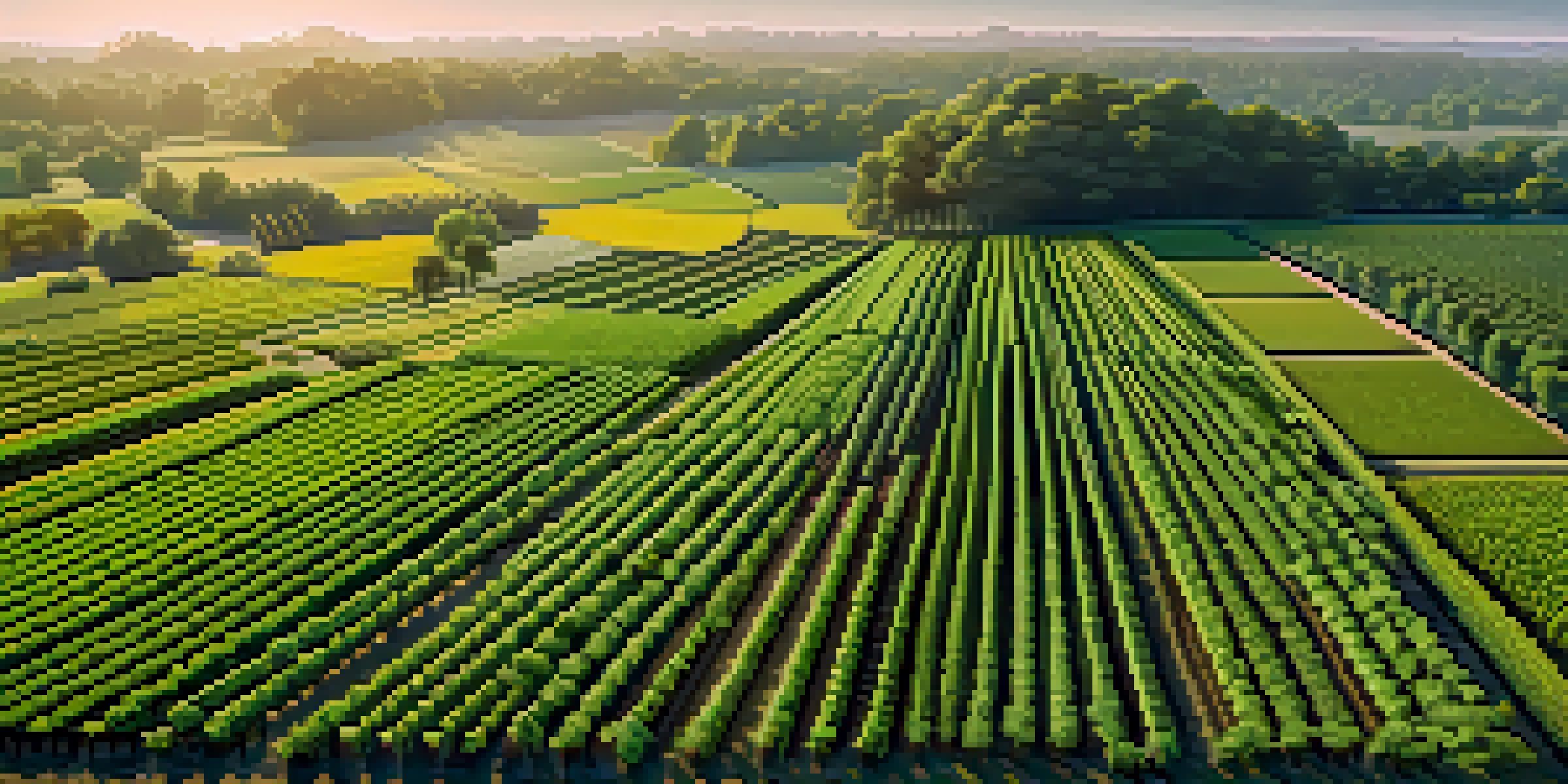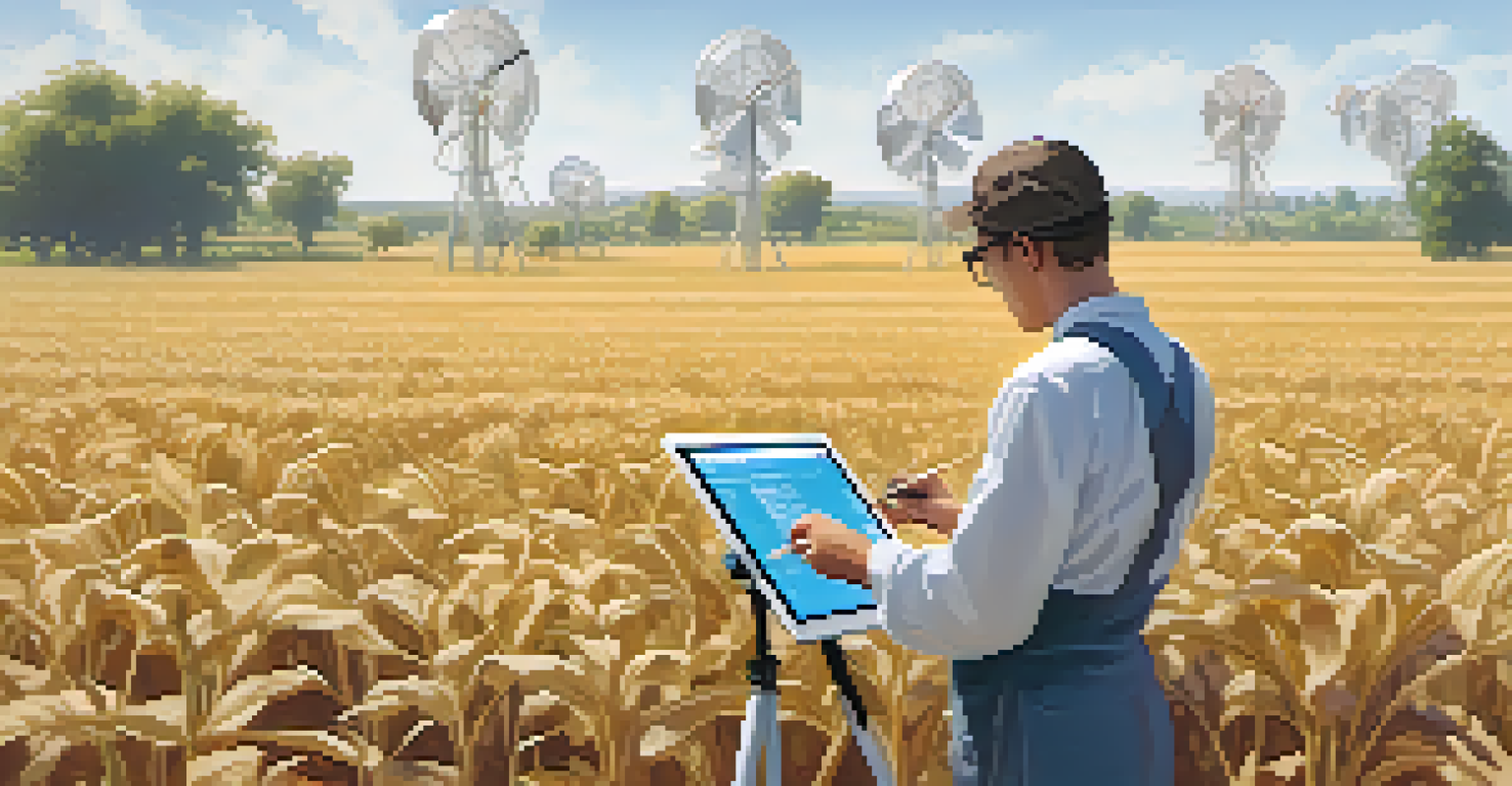Plant Phenotyping: Innovations in Measuring Plant Traits

Understanding Plant Phenotyping and Its Importance
Plant phenotyping refers to the process of measuring and analyzing observable traits in plants, such as height, color, and leaf size. This practice is crucial for researchers and farmers alike, as it helps in understanding how plants respond to their environment. By identifying desirable traits, scientists can aid in the development of crop varieties that are more resilient and productive.
Phenotyping is the bridge between genotype and phenotype, allowing us to understand how the environment interacts with genetics.
The significance of plant phenotyping has grown in recent years due to the challenges posed by climate change and food security. With an increasing global population, the demand for efficient agricultural practices is paramount. For instance, phenotyping can help in breeding plants that require less water or are resistant to pests, ultimately contributing to sustainable farming.
Moreover, advancements in technology have made phenotyping more accessible and accurate. Innovations such as high-throughput phenotyping and machine learning are transforming how traits are measured and analyzed, leading to quicker and more reliable results. This means that researchers can spend less time on manual measurements and more time on improving crop varieties.
High-Throughput Phenotyping: A Game Changer
High-throughput phenotyping (HTP) is a revolutionary approach that allows for the rapid measurement of plant traits across large populations. Utilizing automated systems and imaging technologies, HTP can analyze thousands of plants simultaneously, providing a wealth of data in a fraction of the time compared to traditional methods. This efficiency is particularly beneficial in research settings where time and resources are often limited.

For example, researchers can use drones equipped with specialized cameras to capture images of crop fields from above. These images can reveal vital information about plant health and growth patterns, helping scientists make informed decisions about breeding and management. The integration of HTP into plant breeding programs is helping to accelerate the development of new varieties with improved traits.
Essential Role of Plant Phenotyping
Plant phenotyping is vital for developing resilient and productive crop varieties in response to environmental challenges.
Additionally, HTP facilitates the identification of subtle phenotypic variations that may not be visible to the naked eye. By analyzing this data, researchers can pinpoint specific genetic markers associated with desirable traits, leading to more targeted breeding efforts. This innovation is not just about speed; it also enhances the precision of plant trait measurements, ultimately resulting in better crop outcomes.
The Role of Imaging Technologies in Phenotyping
Imaging technologies play a pivotal role in modern plant phenotyping, offering detailed insights into plant health and development. Techniques such as infrared imaging, hyperspectral imaging, and 3D modeling enable researchers to visualize plant traits in ways that were previously impossible. Each method provides unique data that, when combined, can paint a comprehensive picture of a plant's status.
The future of agriculture lies in the ability to harness data, and plant phenotyping is at the forefront of this evolution.
For instance, infrared imaging can detect variations in plant temperature, which often indicates water stress or disease. This information allows farmers to take proactive measures, such as irrigation adjustments or targeted pest control, before issues escalate. Hyperspectral imaging, on the other hand, can identify chemical compositions in plant leaves, aiding in nutrient management and disease detection.
Moreover, the advancement of 3D modeling has added a new dimension to plant analysis. By creating three-dimensional representations of plants, researchers can assess growth patterns and structural traits more effectively. This holistic approach to imaging not only enhances our understanding of plant biology but also supports the development of more resilient crops.
Integrating Machine Learning into Plant Phenotyping
Machine learning (ML) is revolutionizing plant phenotyping by enabling the analysis of vast datasets more efficiently. With the ability to recognize patterns and make predictions, ML algorithms can assist researchers in identifying the best traits for breeding programs. This integration of technology not only saves time but also improves the accuracy of trait selection.
For example, researchers can train machine learning models on historical phenotypic data to predict future plant performance under various environmental conditions. By analyzing factors such as temperature, soil type, and water availability, ML can suggest which plant varieties are likely to thrive. This predictive capability is invaluable in the face of changing climate conditions.
High-Throughput Phenotyping Advances
High-throughput phenotyping utilizes automated technologies to rapidly measure plant traits, enhancing research efficiency.
Furthermore, ML can automate the analysis of imaging data, significantly reducing the manual effort involved in trait assessment. This means that researchers can focus on interpreting results and making strategic decisions rather than getting bogged down in data processing. The combination of machine learning and phenotyping is paving the way for smarter, more efficient agriculture.
Field Trials: The Testing Ground for Innovations
Field trials are essential for validating the effectiveness of new phenotyping technologies and techniques. These trials provide a real-world setting where researchers can observe how plants respond to various treatments and environmental conditions. By conducting these tests, scientists can assess the reliability of their findings before implementing them on a larger scale.
During field trials, researchers often use a combination of traditional and innovative phenotyping methods to gather comprehensive data. For instance, they might measure plant height manually while also utilizing drones for aerial imaging. This multifaceted approach ensures that researchers capture a wide range of data, leading to more robust conclusions.
Moreover, field trials help in bridging the gap between laboratory research and practical applications in agriculture. By demonstrating the benefits of advanced phenotyping techniques in real agricultural settings, researchers can encourage adoption among farmers. This collaboration between science and agriculture is crucial for advancing sustainable farming practices.
Challenges in Plant Phenotyping and Innovations to Overcome Them
Despite the advancements in plant phenotyping, several challenges remain. One significant issue is the variability in environmental conditions that can affect plant growth and trait expression. Factors like soil quality, temperature fluctuations, and pest pressures can skew results, making it difficult to derive consistent conclusions from phenotypic measurements.
Innovative solutions are being developed to address these challenges. For example, researchers are increasingly using controlled environment systems that simulate specific conditions to study plant responses more accurately. These systems allow for the meticulous control of variables, enabling scientists to isolate the effects of specific traits without the interference of external factors.
Future Innovations in Agriculture
The integration of IoT and genetic engineering in phenotyping is expected to drive sustainable agricultural practices and improve crop yields.
Additionally, the integration of big data analytics into phenotyping is helping to manage variability. By analyzing large datasets from multiple trials, researchers can identify patterns and correlations that may not be evident in smaller datasets. This ability to synthesize information from diverse sources is crucial for enhancing the reliability of phenotyping results.
Future Directions in Plant Phenotyping Research
As technology continues to evolve, the future of plant phenotyping looks promising. Researchers are exploring the potential of integrating Internet of Things (IoT) devices into phenotyping systems, enabling real-time monitoring of environmental conditions and plant health. This connectivity could provide a continuous stream of data, enhancing decision-making in agricultural practices.
Moreover, advancements in genetic engineering and biotechnology are likely to complement phenotyping efforts. By combining precise trait measurements with genetic information, researchers can create targeted breeding strategies that enhance desired characteristics in crops. This synergy between phenotyping and genetics is expected to yield significant breakthroughs in crop improvement.

Lastly, the growing emphasis on sustainability in agriculture will further drive innovations in plant phenotyping. As the agricultural sector seeks to reduce its environmental impact, phenotyping will play a crucial role in identifying and developing crops that require fewer resources while still delivering high yields. The future of plant phenotyping is not just about measuring traits; it's about transforming agriculture for a sustainable tomorrow.